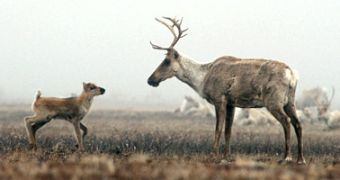Polar bears are highly emblematic in signaling the impact of global warming. The narwhal is the species most vulnerable to global warming. Yet, not only Arctic marine mammals are affected by global warming: western Greenland's caribou experiences a mismatched migration caused by warming, that translates in less and weaker calves, with decreased chances of survival, due to less food available, as revealed by a new research to be published in the Philosophical Transactions of the Royal Society of London.
In recent years, the temperature rise of 7o F (4o C) in spring has made dwarf willows, sedges and other tundra herbs peak earlier, before the arrival of the caribou herds. The reindeer haven't yet changed their arrival time, as they rely not on temperatures but on the length of the day in order to schedule their migrations and calving season.
"For these animals, the cafeteria is closing earlier and earlier. The problem is twofold: Not only can't you rely on getting the best meal when you're most hungry, you also can't rely on being able to keep up with changes to the cafeteria's opening hours in the future. Alone, trophic mismatch might not be the most important factor, but it might be the spark that ignites the forest fire when other factors converge." said co-author Eric Post, a Pennsylvania State University biologist.
During the Arctic frigid winter, Caribous consume lichen dug from under the snow. In spring, the increasing length of the days triggers the migration instinct in females. They move to rich grazing areas to give birth. During this time of plenty, caribou also store fat reserves in order to survive the poor winter diet.
"Caribou are the first terrestrial mammals to be documented with a trophic mismatch," wrote the authors. Some species adapt to the warming effect. A new research has shown that the great tit birds are already doing this in England. This prompts the authors to say that caribou too could adapt to the changing plant cycles.
Reindeer are believed to have appeared during the last glaciation, 110,000 to 10,000 years ago. During the glaciation, the reindeer got to very low latitudes in Europe. The Magdalenian culture of western Europe (from 20,000 to 12,000 years ago) is also called "the age of reindeer", due to reindeer cave paintings found in the caves of Lascaux (France) and Spain (Altamira). This means that caribous have experienced and survived many past climate fluctuations, and that they do represent a surviving Ice Age beast.
Previous research showed that in the past 250 years, the Greenland's caribou population has undergone various cycles, some of which impacted negatively on their calving. The most dramatic warming experienced by the reindeer was at the end of the Ice Age, 10,000 years ago. Nowadays, researchers are worried about the impact the rapid and unpredictable rate of climate change can induce on the reindeer population.
"If this were the only factor caribou had to contend with, they would undoubtedly adjust if the rate of environmental change were constant. Add on top of this the fact that these caribou are also constrained by other factors like winter conditions, population density, human land use, hunting pressure, parasite loads, and competition with musk oxen," Post explained.

 14 DAY TRIAL //
14 DAY TRIAL //